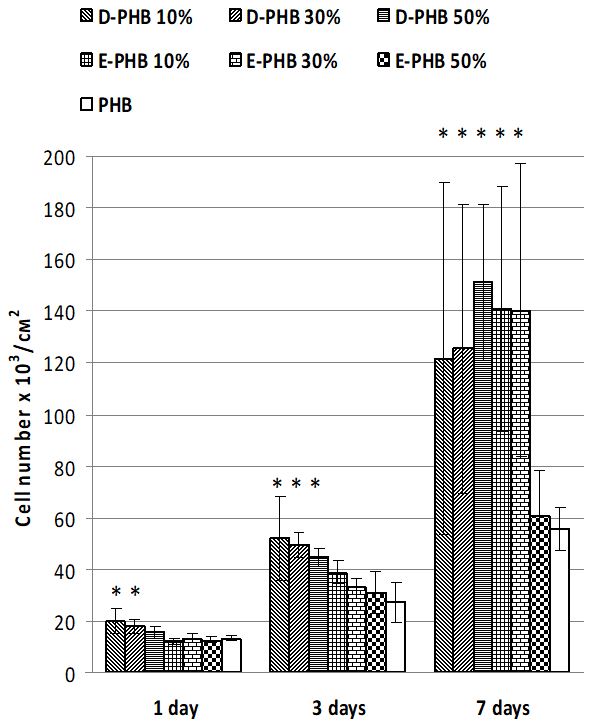
Improvement of biocompatibility of high molecular weight poly-3-hydroxybutyrate by blending with its functionalized oligomers
Abstract
Keywords
Full Text:
PDFReferences
Volova TG. Microbial polyhydroxyalkanoates - plastic materials of the 21st century (biosynthesis, properties, applications). Nova Science Pub. Inc.: New York; 2004. 283 p.
Cortés-Ortiz E, Olayo-Valles R, Rodríguez-Talavera R, González-Torres M, Vargas-Muñoz S, Olayo R, Godinez-Fernández R, Uribe Juárez OE, Morales-Corona J. Plasma functionalized scaffolds of polyhydroxybutyrate electrospun fibers for pancreatic beta cell cultures. Front Mater. 2021;8:600738. doi:10.3389/fmats.2021.600738
Volova TG, Kiselev EG, Vinogradova ON, Nikolaeva ED, Chistyakov AA, Sukovatyi AG, Shishatskaya EI. A glucose-utilizing strain, Сupriavidus eutrophus В-10646: growth kinetics, characterization and synthesis of multicomponent PHAs. PLoS One. 2014;9:e87551. doi:10.1371/journal.pone.0087551
Owens DK, Wendt RC. Estimation of the surface free energy of polymers. J Appl Polym Sci. 1969;13:1741–1747. doi:10.1002/app.1969.070130815
Kaelble DH. Dispersion-polar surface tension properties of organic solids. J Adhes. 1970;2:66–81. doi:10.1080/0021846708544582
dos Santos AJ, Valentina LVOD, Schulz AAH, Duarte MAT. From Obtaining to Degradation of PHB: Material Properties. Part I. Ing Cienc. 2017;13(26):269–298. doi:10.17230/ingciencia.13.26.10
Garcia-Garcia D, Quiles-Carrillo L, Balart R, Torres-Giner S, Arrieta MP. Innovative solutions and challenges to increase the use of Poly(3-hydroxybutyrate) in food packaging and disposables. Eur Polym J. 2022;178:111505. doi:10.1016/j.eurpolymj.2022.111505
Hong S-G, Hsu H-W, Ye M-T. Thermal properties and applications of low molecular weight polyhydroxybutyrate. J Therm Anal Calorim. 2013;111:1243–1250. doi:10.1007/s10973-012-2503-3
van Wachem PB, Beugeling T, Feijen J, Bantjes A, Detmers JP, van Aken WG. Interaction of cultured human-endothelial cells with polymeric surfaces of different wettabilities. Biomater. 1985;6:403–408. doi:10.1016/0142-9612(85)90101-2
Mirmohammadi SA, Khorasani MT, Mirzadeh H, Irani S. Investigation of plasma treatment on poly (3-hydroxybutyrate) film surface: Characterization and invitro assay. Polymer-Plastics Technol Engin. 2012;51:1319–1326. doi:10.1080/03602559.2012.701365
Surmenev RA, Chernozem RV, Syromotina DS, Oehr C, Baumbach T, Krause B, Boyandin AN, Dvoinina LM, Volova TG, Surmeneva MA. Low-temperature argon and ammonia plasma treatment of poly-3-hydroxybutyrate films: Surface topography and chemistry changes affect fibroblast cells in vitro. Eur Polymer J. 2019;112:137–145. doi:10.1016/j.eurpolymj.2018.12.040
Volova TG, Tarasevich AA, Golubev AI, Boyandin AN, Shumilova AA, Nikolaeva ED, Shishatskaya EI. Laser processing of polymer constructs from poly(3-hydroxybutyrate). J Biomater Sci Polymer Edit. 2015;26(16):1210–1228. doi:10.1080/09205063.2015.1082810
Michaljaničová I, Slepička P, Heitz J, Barb RA, Sajdl P, Švorčik V. Comparison of KrF and ArF excimer laser treatment of biopolymer surface. Appl Surface Sci. 2015;339:144–150. doi:10.1016/j.apsusc.2015.02.137
Hu S-G, Jou C-H, Yang M-C. Antibacterial and biodegradable properties of polyhydroxyalkanoates grafted with chitosan and chitooligosaccharides via ozone treatment. J Appl Polymer Sci. 2003;88(12):2797–2803. doi:10.1002/app.12055
Ahad IU, Bartnik A, Fiedorowicz H, Kostecki J, Korczyc B, Ciach T, Brabazon D. Surface modification of polymers for biocompatibility via exposure to extreme ultraviolet radiation. J Biomed Mater Res A. 2014;102(9):3298–3310. doi:10.1002/jbm.a.34958
Boyandin AN, Sukhanova AA, Nikolaeva ED, Nemtsev IV. Chemical modification of films from biosynthetic poly-3-hydroxybutyrate aimed to improvement of their surface properties. Macromol Symp. 2021;395:2000281. doi:10.1002/masy.202000281
Râpă M, Darie-Niţă RN, Grosu E, Tănase EE, Trifoi AR, Pap T, Vasile C. Effect of plasticizers on melt processability and properties of PHB. J Optoelectron Adv Maters. 2015;17(11-12):1778–1784.
Barbosa JL, Perin GB, Felisberti MI. Plasticization of poly(3-hydroxybutyrate-co-3-hydroxyvalerate) with an oligomeric polyester: miscibility and effect of the microstructure and plasticizer distribution on thermal and mechanical properties. ACS Omega. 2021;6:3278−3290. doi:10.1021/acsomega.0c05765
de Sousa Junior RR, dos Santos CAS, Ito NM, Suqueira AN, Lackner M, dos Santos DJ. PHB processability and property improvement with linear-chain polyester oligomers used as plasticizers. Polymers. 2022;14:4197. doi:10.3390/polym14194197
Nguyen S, Yu G, Marchessault RH. Thermal degradation of poly(3-hydroxyalkanoates): preparation of well-defined oligomers. Biomacromolec. 2002;3:219–224. doi:10.1021/bm0156274
Špitalský Z, Lacík I, Lathová E, Janigová I, Chodák I. Controlled degradation of polyhydroxybutyrate via alcoholysis with ethylene glycol or glycerol. Polym Degrad Stab. 2006;91:856–861. doi:10.1016/j.polymdegradstab.2005.06.019
Leimann FV, Cardozo Filho L, Sayer C, Araújo PHH. Poly(3-hydroxybutyrate-co-3-hydroxyvalerate) nanoparticles prepared by a miniemulsion/solvent evaporation technique. Effect of PHBV molar mass and concentration. Braz J Chem Engin. 2013;30:369–377. doi:10.1590/S0104-66322013000200014
Boyandin AN, Bessonova VA, Ertiletskaya NL, Sukhanova AA, Shalygina TA, Kondrasenko AA. Aminolysis of poly-3-hydroxybutyrate in N,N-dimethylformamide and 1,4-dioxane and formation of functionalized oligomers. Polymers. 2022;14:5481. doi:10.3390/polym14245481
Syromotina DS, Surmenev RA, Surmeneva MA, Boyandin AN, Epple M, Ulbricht M, Oehr C, Volova TG. Oxygen and ammonia plasma treatment of poly(3-hydroxybutyrate) films for controlled surface zeta potential and improved cell compatibility. Mater Lett. 2016;163:277–280. doi:10.1016/j.matlet.2015.10.080
Zhu Y, Mao Z, Gao C. Aminolysis-based surface modification of polyesters for biomedical applications. RSC Adv. 2013;3:2509. doi:10.1039/c2ra22358a
DOI: https://doi.org/10.15826/chimtech.2024.11.1.01
Copyright (c) 2023 Anatoly N. Boyandin, Ljublyana M. Dvoinina, Aleksey G. Sukovatyi, Anna A. Sukhanova, Natalya L. Ertiletskaya

This work is licensed under a Creative Commons Attribution 4.0 International License.
© Website Chimica Techno Acta, 2014–2024
ISSN 2411-1414 (Online)
This journal is licensed under a Creative Commons Attribution 4.0 International







